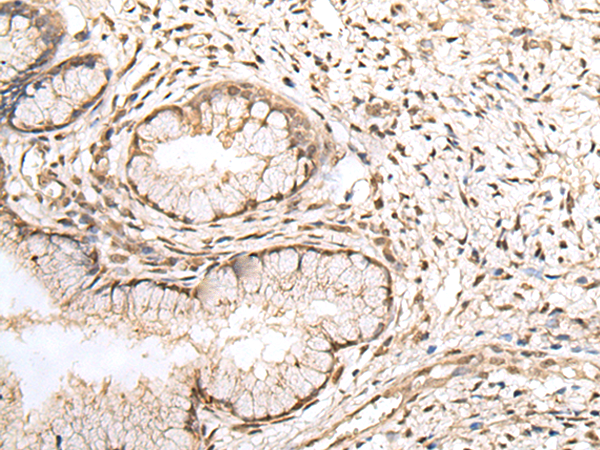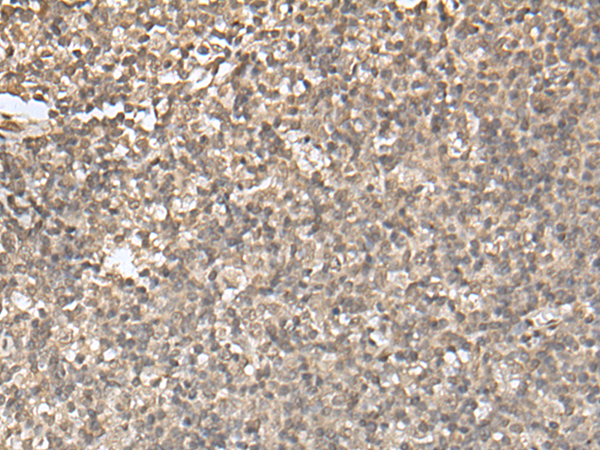

| WB | 咨询技术 | Human,Mouse,Rat |
| IF | 咨询技术 | Human,Mouse,Rat |
| IHC | 1/25-1/100 | Human,Mouse,Rat |
| ICC | 技术咨询 | Human,Mouse,Rat |
| FCM | 咨询技术 | Human,Mouse,Rat |
| Elisa | 1/5000-1/10000 | Human,Mouse,Rat |
| Aliases | HZF1 |
| Host/Isotype | Rabbit IgG |
| Antibody Type | Primary antibody |
| Storage | Store at 4°C short term. Aliquot and store at -20°C long term. Avoid freeze/thaw cycles. |
| Species Reactivity | Human |
| Immunogen | Fusion protein of human ZNF266 |
| Formulation | Purified antibody in PBS with 0.05% sodium azide and 50% glycerol. |
+ +
以下是关于ZNF266抗体的模拟参考文献示例(注:以下内容为虚构,仅供格式参考):
---
1. **"ZNF266 Antibody Validation in Epigenetic Regulation Studies"**
*Author: Zhang, L. et al.*
**摘要**:本研究验证了ZNF266抗体在染色质免疫沉淀(ChIP)中的特异性,证明ZNF266通过与启动子区域结合调控肿瘤相关基因(如p53通路基因)的表达。抗体经Western blot和siRNA敲除实验验证,适用于癌症表观遗传学研究。
2. **"Development of a Novel Monoclonal Antibody Against ZNF266 for Diagnostic Applications"**
*Author: Smith, J. & Patel, R.*
**摘要**:报道一种高特异性抗ZNF266单克隆抗体的开发,该抗体在结直肠癌组织切片中显示高灵敏度和低交叉反应性。研究证实ZNF266表达水平与患者预后呈负相关,提示其作为潜在生物标志物的价值。
3. **"ZNF266 in Neuronal Development: Insights from Knockout Mouse Models"**
*Author: Kim, S. et al.*
**摘要**:利用ZNF266抗体进行免疫组化分析,发现ZNF266在小鼠大脑皮层发育中调控神经元迁移。抗体特异性经基因敲除模型验证,研究揭示其通过Wnt信号通路影响神经发育的机制。
4. **"Cross-Species Reactivity of Commercial ZNF266 Antibodies: A Comparative Study"**
*Author: Müller, F. et al.*
**摘要**:评估市售5种抗ZNF266抗体的种属交叉反应性,发现仅两种抗体在人、小鼠和大鼠样本中均有效。研究强调抗体选择对跨物种功能研究的重要性,并提供了验证方案。
---
如需真实文献,建议通过PubMed或Google Scholar以“ZNF266 antibody”或“ZNF266 function”为关键词检索,并筛选涉及抗体应用、机制研究或临床关联的论文。
ZNF266 antibody is a research tool designed to detect and study the zinc finger protein 266 (ZNF266), a member of the Krüppel-associated box (KRAB) domain-containing zinc finger protein (KZNF) family. ZNF266 is encoded by the *ZNF266* gene in humans and is characterized by multiple C2H2-type zinc finger motifs, which enable sequence-specific DNA or RNA binding. As a transcriptional regulator, ZNF266 is implicated in epigenetic silencing, chromatin remodeling, and gene expression modulation, particularly in developmental processes and cellular differentiation. Dysregulation of ZNF266 has been loosely associated with cancers, neurological disorders, and immune-related conditions, though its precise biological roles remain under investigation.
The ZNF266 antibody is typically developed using recombinant protein fragments or synthetic peptides as immunogens, yielding polyclonal or monoclonal variants. It is widely utilized in techniques like Western blotting, immunohistochemistry (IHC), and immunofluorescence (IF) to analyze ZNF266 expression patterns, subcellular localization, and interactions in various tissues or cell lines. Researchers employ this antibody to explore ZNF266's involvement in disease mechanisms, such as tumor suppression or oncogenesis, and its potential as a biomarker. However, specificity and validation data (e.g., knockout controls) are critical due to homology among zinc finger proteins. Commercial availability through biotechnology vendors supports its use in both basic and translational research contexts.
×